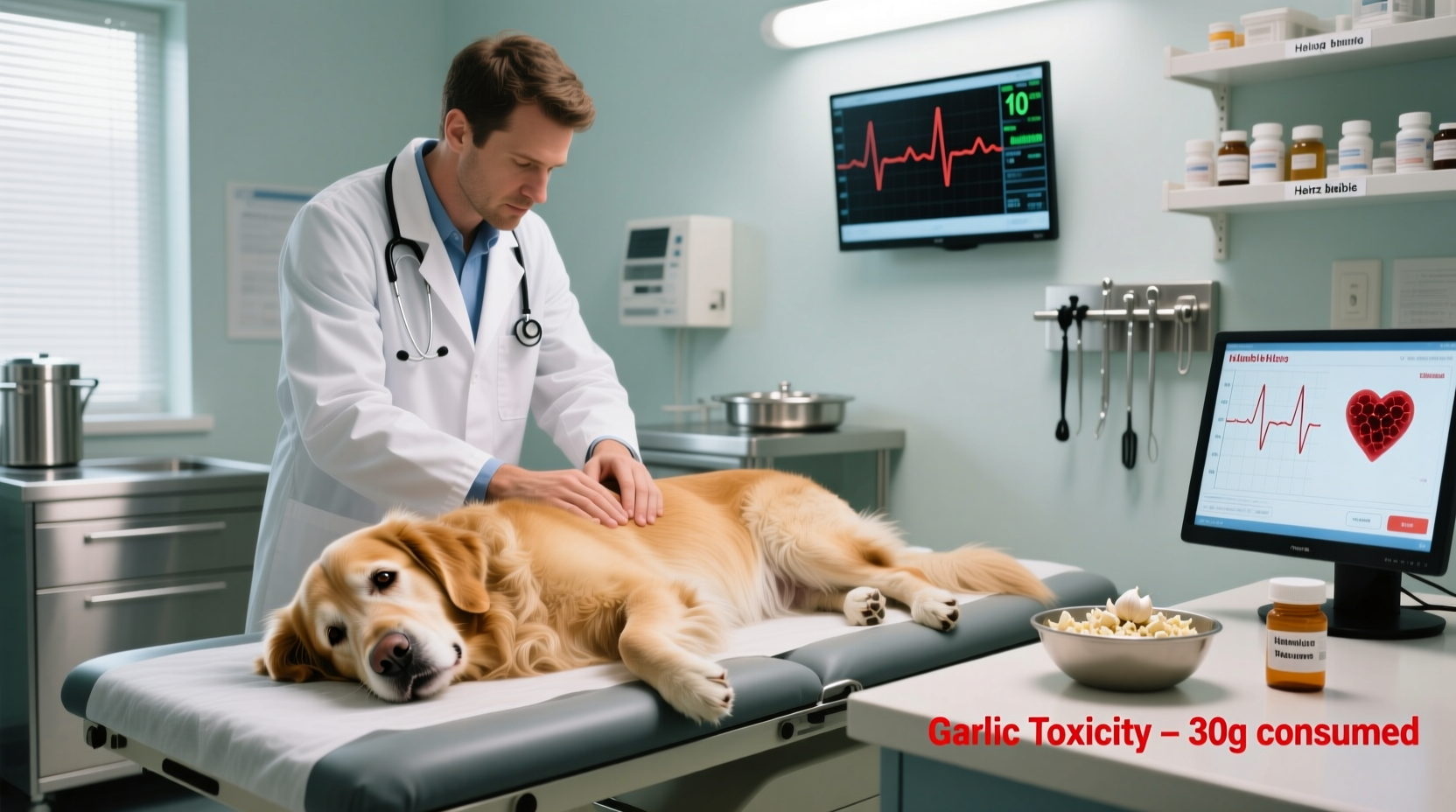Garlic is toxic to dogs and can cause life-threatening hemolytic anemia. Even small amounts can be harmful, with toxicity occurring at approximately 15-30 grams of garlic per kilogram of body weight. If your dog has consumed garlic, contact your veterinarian or an animal poison control center immediately.
When your dog accidentally eats garlic, every minute counts. This comprehensive guide provides vet-verified information about garlic toxicity in dogs, including precise toxic thresholds, symptom progression timelines, and immediate action steps that could save your pet's life. Understanding the science behind garlic poisoning helps you make informed decisions when seconds matter.
Why Garlic Poses a Serious Threat to Dogs
Garlic contains N-propyl disulfide, a compound that damages red blood cells in dogs, leading to hemolytic anemia. Unlike humans, dogs lack the metabolic pathway to safely process these sulfur compounds. The Veterinary Information Network confirms that garlic is five times more toxic to dogs than onions, making even small exposures potentially dangerous.
| Garlic Form | Toxic Dose (per 20lb dog) | Severe Risk Threshold |
|---|---|---|
| Fresh garlic cloves | 1-2 cloves | 4+ cloves |
| Garlic powder | 1/2 teaspoon | 2+ teaspoons |
| Garlic supplement | 1 capsule | 3+ capsules |
| Garlic bread | 2-3 slices | 6+ slices |
This fact comparison table, based on data from the ASPCA Animal Poison Control Center, shows how different garlic forms present varying risk levels. Powdered garlic concentrates the toxic compounds, making it especially dangerous in small quantities.
Recognizing Garlic Poisoning: Symptom Timeline
Garlic toxicity symptoms don't appear immediately. Understanding this progression timeline helps you recognize developing poisoning:
- 0-24 hours: Vomiting, diarrhea, abdominal pain (often missed as general stomach upset)
- 24-72 hours: Lethargy, weakness, pale gums, increased breathing rate
- 3-5 days: Dark urine (hemoglobinuria), jaundice, collapse from severe anemia
- 5+ days: Potential organ damage from prolonged oxygen deprivation
This symptom progression timeline, verified by the Pet Poison Helpline, demonstrates why early intervention is critical. Many owners mistake initial symptoms for minor stomach issues, delaying treatment until serious damage occurs.
Immediate Actions When Garlic Exposure Occurs
If your dog consumes garlic, follow these vet-recommended steps:
- Calculate exposure amount: Weigh any remaining garlic or packaging to determine approximate consumption
- Contact professionals immediately: Call your veterinarian or the ASPCA Animal Poison Control Center (888-426-4435)
- Do NOT induce vomiting without professional guidance - this can cause additional complications
- Preserve evidence: Save packaging or remaining food for identification
- Monitor closely: Note exact time of consumption and any developing symptoms
Professional Treatment Protocols
Veterinarians use specific protocols for garlic toxicity cases:
- Early intervention (within 2 hours): Activated charcoal administration to prevent absorption
- Blood work monitoring: Serial PCV (packed cell volume) tests to track anemia development
- Supportive care: IV fluids, oxygen therapy, and anti-nausea medications
- Severe cases: Blood transfusions for critically low red blood cell counts
According to Cornell University College of Veterinary Medicine research, dogs treated within 12 hours of garlic ingestion have significantly better outcomes than those receiving delayed care. Early intervention prevents the oxidative damage that leads to red blood cell destruction.

Common Sources of Hidden Garlic Exposure
Many dog owners don't realize these everyday items contain dangerous garlic levels:
- Homemade broths and gravies
- Commercial dog treats with "natural flavors"
- Leftover human foods (pizza, pasta dishes, sauces)
- Garlic supplements marketed for "pet health"
- "Natural" flea repellent products
Context boundaries matter significantly here. While small garlic traces in commercial dog food are generally regulated to safe levels, homemade recipes and human foods often contain dangerous concentrations. The FDA's Center for Veterinary Medicine warns that "natural" pet products frequently contain unregulated garlic doses that exceed safety thresholds.
Safe Flavor Alternatives for Dogs
Instead of garlic, consider these vet-approved flavor enhancers:
- Parsley (fresh, in small amounts)
- Basil (finely chopped)
- Carrot puree
- Pumpkin (canned, plain)
- Low-sodium chicken broth (garlic-free)
Always introduce new foods gradually and consult your veterinarian before making dietary changes, especially for dogs with existing health conditions.
Preventing Future Garlic Exposure
Implement these safety measures:
- Store human foods securely away from curious dogs
- Read all ingredient labels on commercial dog products
- Educate family members about toxic foods
- Keep emergency numbers readily accessible
- Consider pet-proofing your kitchen during cooking
Remember that garlic toxicity is dose-dependent but cumulative. Repeated small exposures can be as dangerous as a single large ingestion. The Merck Veterinary Manual emphasizes that "there is no known safe threshold for garlic consumption in dogs," making prevention crucial.











 浙公网安备
33010002000092号
浙公网安备
33010002000092号 浙B2-20120091-4
浙B2-20120091-4